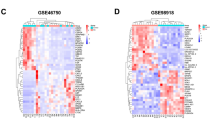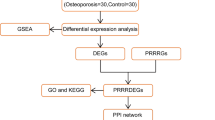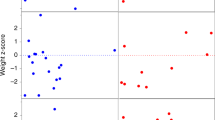Abstract
Gerodermia osteodysplastica is a recessive segmental progeroid disorder mainly characterized by wrinkled skin, generalized connective tissue weakness, infantile onset osteoporosis and normal intelligence. Coding mutations in GORAB, localized on chromosome 1q24.2, are the cause of this disease. 1q24 deletions underlie a spectrum of disorders with intellectual disability and ear abnormalities as phenotypic hallmarks. Here we report on an individual from Azerbaijan originating from a non-consanguineous couple showing short stature, cutis laxa, frequent fractures, facial dysmorphism, cup-shaped ears and intellectual disability. Sanger sequencing of GORAB revealed the seemingly homozygous missense mutation p.Ser175Phe. This mutation was detected in a heterozygous state in the clinically unaffected mother, but was absent in the healthy father. We performed copy-number investigations by high-resolution array-CGH and PCR approaches and found an ~6 Mb de novo deletion spanning 1q23.3-q24.2 in the affected boy. This novel combination of genetic defects very well explains the phenotype that goes beyond the usual presentation of gerodermia osteodysplastica. Our data provide new insight into the phenotypic spectrum of 1q23-q25 deletions and shows that the combination with another pathogenic allele can lead to more severe clinical manifestations.
Similar content being viewed by others
Log in or create a free account to read this content
Gain free access to this article, as well as selected content from this journal and more on nature.com
or
References
Morava, E., Guillard, M., Lefeber, D. J. & Wevers, R. A. Autosomal recessive cutis laxa syndrome revisited. Eur. J. Hum. Genet. 17, 1099–1110 (2009).
Baumgartner, M. R., Hu, C. A., Almashanu, S., Steel, G., Obie, C., Aral, B. et al. Hyperammonemia with reduced ornithine, citrulline, arginine and proline: a new inborn error caused by a mutation in the gene encoding delta(1)-pyrroline-5-carboxylate synthase. Hum. Mol. Genet. 9, 2853–2858 (2000).
Hennies, H. C., Kornak, U., Zhang, H., Egerer, J., Zhang, X., Seifert, W. et al. Gerodermia osteodysplastica is caused by mutations in SCYL1BP1, a Rab-6 interacting golgin. Nat. Genet. 40, 1410–1412 (2008).
Kornak, U., Reynders, E., Dimopoulou, A., van Reeuwijk, J., Fischer, B., Rajab, A. et al. Impaired glycosylation and cutis laxa caused by mutations in the vesicular H+-ATPase subunit ATP6V0A2. Nat. Genet. 40, 32–34 (2008).
Reversade, B., Escande-Beillard, N., Dimopoulou, A., Fischer, B., Chng, S. C., Li, Y. et al. Mutations in PYCR1 cause cutis laxa with progeroid features. Nat. Genet. 41, 1016–1021 (2009).
Dimopoulou, A., Fischer, B., Gardeitchik, T., Schroter, P., Kayserili, H., Schlack, C. et al. Genotype-phenotype spectrum of PYCR1-related autosomal recessive cutis laxa. Mol. Genet. Metab. 110, 352–361 (2013).
Fischer-Zirnsak, B., Escande-Beillard, N., Ganesh, J., Tan, Y. X., Al Bughaili, M., Lin, A. E. et al. Recurrent de novo mutations affecting residue Arg138 of pyrroline-5-carboxylate synthase cause a progeroid form of autosomal-dominant cutis laxa. Am. J. Hum. Genet. 97, 483–492 (2015).
Kouwenberg, D., Gardeitchik, T., Wevers, R. A., Haberle, J. & Morava, E. Recognizable phenotype with common occurrence of microcephaly, psychomotor retardation, but no spontaneous bone fractures in autosomal recessive cutis laxa type IIB due to PYCR1 mutations. Am. J. Med. Genet. A 155A, 2331–2332 (2011).
Yildirim, Y., Tolun, A. & Tuysuz, B. The phenotype caused by PYCR1 mutations corresponds to geroderma osteodysplasticum rather than autosomal recessive cutis laxa type 2. Am. J. Med. Genet. A 155A, 134–140 (2011).
Egerer, J., Emmerich, D., Fischer-Zirnsak, B., Chan, W. L., Meierhofer, D., Tuysuz, B. et al. GORAB missense mutations disrupt RAB6 and ARF5 binding and golgi targeting. J. Invest. Dermatol. 135, 2368–2376 (2015).
Rajab, A., Kornak, U., Budde, B. S., Hoffmann, K., Jaeken, J., Nurnberg, P. et al. Geroderma osteodysplasticum hereditaria and wrinkly skin syndrome in 22 patients from Oman. Am. J. Med. Genet. A 146A, 965–976 (2008).
Burkardt, D. D., Rosenfeld, J. A., Helgeson, M. L., Angle, B., Banks, V., Smith, W. E. et al. Distinctive phenotype in 9 patients with deletion of chromosome 1q24-q25. Am. J. Med. Genet. A 155A, 1336–1351 (2011).
Chatron, N., Haddad, V., Andrieux, J., Desir, J., Boute, O., Dieux, A. et al. Refinement of genotype-phenotype correlation in 18 patients carrying a 1q24q25 deletion. Am. J. Med. Genet. A 167A, 1008–1017 (2015).
Mackenroth, L., Hackmann, K., Klink, B., Weber, J. S., Mayer, B., Schrock, E. et al. Interstitial 1q23.3q24.1 deletion in a patient with renal malformation, congenital heart disease, and mild intellectual disability. Am. J. Med. Genet. A 170, 2394–2399 (2016).
Gardeitchik, T., Mohamed, M., Fischer, B., Lammens, M., Lefeber, D., Lace, B. et al. Clinical and biochemical features guiding the diagnostics in neurometabolic cutis laxa. Eur. J. Hum. Genet. 22, 888–895 (2014).
Bedeschi, M. F., Colombo, L., Mari, F., Hofmann, K., Rauch, A., Gentilin, B. et al. Unmasking of a recessive SCARF2 mutation by a 22q11.12 de novo deletion in a patient with Van den Ende-Gupta Syndrome. Mol. Syndromol. 1, 239–245 (2010).
Acknowledgements
We thank the patient and his family for participating in this study. We thank Fabienne Pritsch for excellent technical assistance. This work was funded by the German Federal Ministry of Education and Research (BMBF) (grant 01EC1402B, DIMEOs) and the Elsbeth Bonhoff Stiftung.
Author information
Authors and Affiliations
Corresponding author
Ethics declarations
Competing interests
The authors declare no conflict of interest.
Additional information
Supplementary Information accompanies the paper on Journal of Human Genetics website
Supplementary information
Rights and permissions
About this article
Cite this article
Al-Bughaili, M., Neuhann, T., Flöttmann, R. et al. A de novo 1q23.3-q24.2 deletion combined with a GORAB missense mutation causes a distinctive phenotype with cutis laxa. J Hum Genet 62, 325–328 (2017). https://doi.org/10.1038/jhg.2016.111
Received:
Revised:
Accepted:
Published:
Issue date:
DOI: https://doi.org/10.1038/jhg.2016.111
This article is cited by
-
mTORC1 controls Golgi architecture and vesicle secretion by phosphorylation of SCYL1
Nature Communications (2022)
-
Narrowing down the region responsible for 1q23.3q24.1 microdeletion by identifying the smallest deletion
Human Genome Variation (2019)



